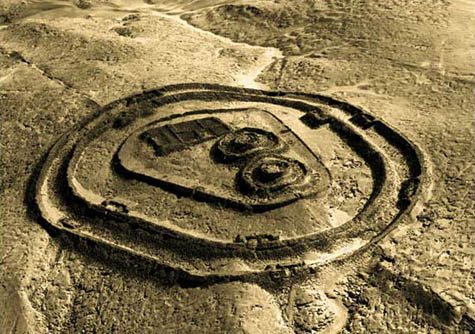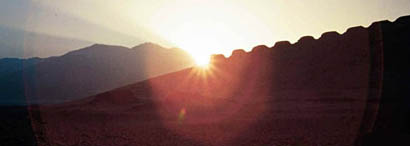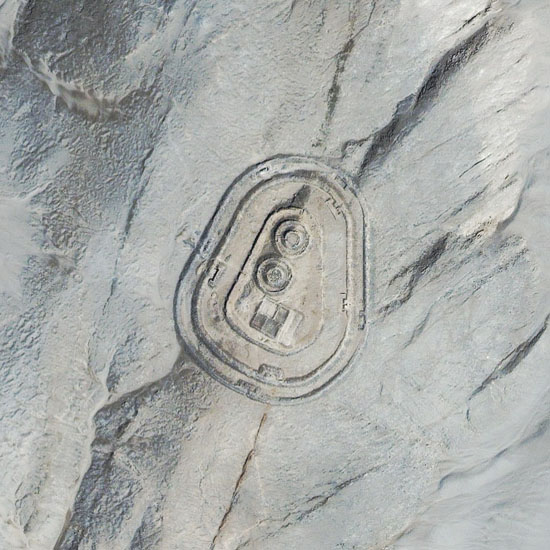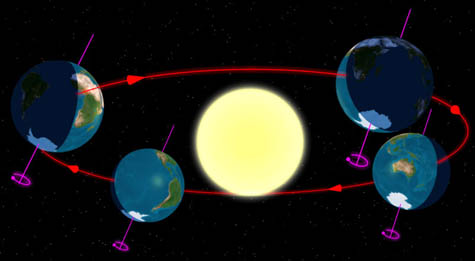The architecture of solar alignments
 [Image: The solar-aligned ruins of Chankillo, Peru; via the BBC].
[Image: The solar-aligned ruins of Chankillo, Peru; via the BBC].The Chankillo ruins, near the Peruvian coast, made the news a few months back when they were discovered to be an ancient solar observatory.
According to NASA, some archaeologists "have nicknamed the ruin’s central complex the 'Norelco ruin' based on its resemblance to a modern electric shaver."
Just southeast of the "electric shaver," however, are a series of structures called "the Thirteen Towers, which vaguely resemble a slightly curved spine."
 [Image: Photo by Ivan Ghezzi, demonstrating solar alignments with the "slightly curved spine" of the Thirteen Towers; via the BBC].
[Image: Photo by Ivan Ghezzi, demonstrating solar alignments with the "slightly curved spine" of the Thirteen Towers; via the BBC].Quoting NASA:
- The Thirteen Towers were the key to the scientists conclusion that the site was a solar observatory. These regularly spaced towers line up along a hill, separated by about 5 meters (16 feet). The towers are easily seen from Chankillo’s central complex, but the views of these towers from the eastern and western observing points are especially illuminating. These viewpoints are situated so that, on the winter and summer solstices, the sunrises and sunsets line up with the towers at either end of the line. Other solar events, such as the rising and setting of the Sun at the mid-points between the solstices, were aligned with different towers.
 [Image: Like some kind of machine embedded in the surface of the earth, it's the Chankillo Observatory. Courtesy of GeoEye/SIME, via NASA's Earth Observatory].
[Image: Like some kind of machine embedded in the surface of the earth, it's the Chankillo Observatory. Courtesy of GeoEye/SIME, via NASA's Earth Observatory].For all that, though, the surrounding landscape at Chankillo is itself just extraordinary; you can't see it in the images above, however, so take a look at this image – or even at this huge version of that image, or even at this truly gigantic (3.4mb) version.
Meanwhile, I'm a genuine sucker for solar-alignment theories involving landscapes and architecture; in fact, I was just talking to someone about this the other day.
Yet I'm even more of a sucker for unintentional examples of such things – like houses with pitched gable roofs that accidentally line-up with the sun every summer solstice...
I've talked about this kind of thing on BLDGBLOG before – but that doesn't mean I won't do it again.
For instance: one day, a science writer in her late 30s gets an email saying that she's being sent to report on iceberg calving off the western coast of Greenland.
She takes a boat, along with some climate scientists and oceanographers, and they find themselves inside the region of study by the second week of June. Icebergs are flowing past the ship on all sides; no one can believe how many there are. Measurements are taken; the icebergs continue to drift.
The days grow longer.
 [Image: Via Wikipedia].
[Image: Via Wikipedia].Then, on the morning of the summer solstice, our science journalist can't sleep. She's been up all night, flipping her pillow over and back, shoving the blankets off then pulling them tight again, etc. etc.
Finally, she gets out of bed and wanders out onto the deck of the ship – where she sees the sun of the summer solstice just hanging there.
Incredibly, though, a perfect line of drifting icebergs – ten, twenty, thirty icebergs – stretches out, one after the other, toward the horizon. The effect is uncanny; it looks as if the icebergs have been deliberately placed there, sculpted into an unbroken line by unseen forces – and right above them, of course, is the summer sun, casting a reflective line of golden light from one icy peak to the next.
It's as if, for that precise moment, from the deck of that particular ship, for that one woman alone, the Arctic seascape has been arranged to line up with the solstice.
In any case, I think there should be an ongoing competition – or at least some kind of internet archive – for photographic proof of unexpected solar alignments: four times a year, perhaps – on the solstices and equinoxes – you go out and search for weird alignments of the sun...
In a small town outside Albany, the windows of every house in one particular cul-de-sac light up, the sun shining straight through house after house, in a perfectly straight line, as if they'd been built for the purpose, a monumental solar observatory the exact size and shape of suburbia – till one family closes their curtains, and the effect is gone.
(Earth Observatory image found via del.icio.us/pruned).





Comments are moderated.
If it's not spam, it will appear here shortly!
a heretical splinter group would be dual sonar & lunar alignments... those fine days when both appear in the sky, but you just can't manage to bring them into view simultaneously, without turning your head... perfect aligns would find both in the field of vision, whilst looking through the 173rd floor window of a fully-restored 22nd century nanotel... or summit like that...
I can't help but think of Chaco Canyon and Anna Sofaer's research on solar/lunar alignment markings in the area and her contention that the Anasazi's buildings were located in the canyon to align with the solstices and equinoxes. She might be reaching in some of her ideas, though I can empathize with her wanting to believe that people living in a time without artificial lighting, air conditioning, and Jesus Christ took cues from the sun, moon, and stars, consciously or not. It makes me glad there's people like James Turrell who don't deny a connection to the comsmos.
do you think the observer in the story would be drawn with the same force that took hold of the ice?
Post a Comment